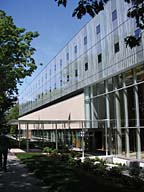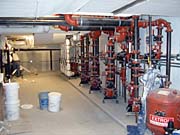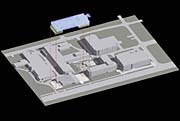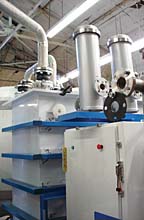
PM Engineeris proud to announce that one winner and an honorable mention have been chosen to receivePMEExcellence in Design Awards for 2005. Congratulations to Omicron Architecture Engineering Construction, LLC, of Vancouver, BC, Canada for its Fred Kaiser Building project, and to Practical Applications, Inc., of Boston, MA, for its BSL-3 Steam Kill System. These designs were judged by our distinguished panel of editors, engineers and consultants, based on the following criteria: innovation in design, customer satisfaction, ability to meet schedules, cost-efficient strategies, and community improvement. Nominated designs could be submitted by consulting, specifying or design engineering firms.

PM Engineer was impressed with the overall concept applied in the design of this heating and cooling system, as well as the water conservation in the plumbing design. The heating and cooling design embodies what the engineering profession can accomplish in meeting the comfort conditions of the building occupants while conserving energy. The design identifies some of the superior qualities of a hydronic system over other system designs.

Omicron Architecture Engineering Construction, Fred Kaiser Building (Vancouver, BC, Canada)
Omicron is an integrated architectural, interior design, engineering and construction firm that provides total building solutions. A privately-owned design and construction company, it was launched in 1998 and is organized by market segments, including commercial, institutional, retail and renewal sectors.Omicron completed The Fred Kaiser Building at the University of British Columbia this past spring, which houses the offices of Electrical and Computer Engineering, and Applied Science. It will house almost 700 occupants consisting of faculty, researchers, administrators and students. The building provides for flexible lab space, offices, meeting rooms and a large seminar facility. Given a very limited site, the project of 96,000 sq. ft. was built over an existing building while it remained in operation. The project was designed to exceed the University of British Columbia's Sustainability Guidelines, while maintaining a strict project cost budget limitation, using a fast-track construction management process to meet the schedule of a spring 2005 completion.
The design team included: Omicron Mechanical Engineers Geoff McDonell, P.Eng., LEED AP, and Rod Yeoh, P.Eng., LEED AP; Structural Engineer: Andrew Metten, P.Eng. of Bush Bohlman Partners; and Electrical Engineers Thys Fourie, P.Eng and Dean Kaardal, P.Eng, of Stantec Consulting. Architecture of the building is jointly credited to Omicron and Architects Alliance-Michael McColl, MAIBC and Adrian DiCastri, OAA.

HVAC Systems
The structure not only holds up the building and gives it form, but it also heats and cools the interior spaces of the building. Approximately 65,000 feet of 3/4-in. diameter PEX tubing cast into the slab allows warm and cool water to be circulated through the entire structural floor slab system to create large radiant ceiling "panels"

Plumbing/Piping Systems
Potable water efficiency for the building was designed to be more than 50% above a conventional building, by installing "dual flush"
Customer Satisfaction, Meeting Schedules, Reducing Cost
The radiant slab system met the LEED requirements for energy, indoor comfort quality and cost control that the client had set for the project. While high-performance envelope components were required with this system, the cost was offset by savings in the mechanical and electrical systems resulting in no net extra project costs. Extensive computer modeling was undertaken to simulate the system to ensure that indoor comfort requirements could be met at all times. The project was completed on time and on budget, in spite of extreme budget pressures resulting from the general construction materials and trades cost inflation that occurred over the last year in the area.The project was a "fast tracked"

How Does the Project Improve the Community?
This project will use 35% less energy overall compared to a conventional "all-air"Honorable Mention
Practical Applications, Inc.'s (PAI) design of the biological wastewater steam kill system for the University of Pittsburgh BSL-3 Laboratory receives an honorable mention in this year's Design in Excellence Award. The design of the treatment system addresses the on-site concerns for pretreatment of bio-hazard waste. The design uses a common means of killing the biological waste, steam. The plumbing codes limit the discharge temperature of all waste. The system design addresses this concern with a heat exchanger.This design by PAI is being used in the design of other BSL-3 laboratories across the country. PM Engineer applauds Practical Applications, Inc. for the dedication to environmentally sound pretreatment of biological wastewater.

Practical Applications, Inc., BSL-3 Steam Kill System for the Regional Biocontainment Laboratory at the University of Pittsburgh
(Boston, MA)
Boston-based Practical Applications specializes in the design, installation, and maintenance of industrial process water and wastewater systems. The company has won the bid to design and construct the BSL-3 Steam Kill System for the Regional Biocontainment Laboratory at the University of Pittsburgh. The Pittsburgh facility is one of nine biocontainment laboratories under construction across the country to study diseases and viruses that theoretically could be used as weapons by terrorists. The system will be used to kill biological pathogens found in laboratory wastewater generated by the university as it studies emerging infectious diseases.The project is led by Joshua Jondro, Project Engineer/Chemical Engineer. PAI will complete the system's design and electrical equipment fabrication at its new facility located in the EDIC Marine Industrial Park, Boston. All tank fabrication and testing will be completed at PAI's South Boston Fabrication Facility. It will then be taken apart and shipped to Pittsburgh, where it will be re-assembled and fit within the dimensions of a room still being constructed.
The system collects all wastewater generated by the BSL-3 laboratories in a special sealed 6,500-gallon tank. As demand requires, the wastewater is transferred to one of three 1,500-gallon "Steam Kill"
Piping Systems
This project has unique plumbing and piping systems, including medium pressure steam, welded stainless steel piping, welded polypropylene piping, special coatings, pressure vessels, and automatic valves. The way the pipes are connected is a very important part of such a system. If there are threaded pipe sections, there would be a risk of contaminated water leaking out. This design consists of schedule 10 welded stainless steel pipe, with pipe connections either welded or flanged, eliminating the need for any threaded sections.In addition, there are only a handful of similar treatment systems existing in the United States. The ultimate challenge was to design a system that is reliable, safe, and easy to operate while maintaining a finite barrier to the bio-hazard.
Meeting Schedules and Reducing Cost
PAI minimized schedule delays by ordering in advance major control components (i.e., control valves, control panel equipment) and pre-testing the equipment prior to installation on the system skid.Costs were minimized by selecting vendors whose core business was in-line with the required item.
How Does the Project Improve the Community?
The treatment system allows scientists to safely research hazardous biological agents without impacting the community. The research laboratory also provides a local facility for the community to promptly mitigate public health episodes.Overall, PAI's improved research will allow the United States to prevent disease, guard against bio-terrorist attacks, and maintain the worldwide lead in biological research.
For more information on Practical Applications, visit www.pai-online.com.
